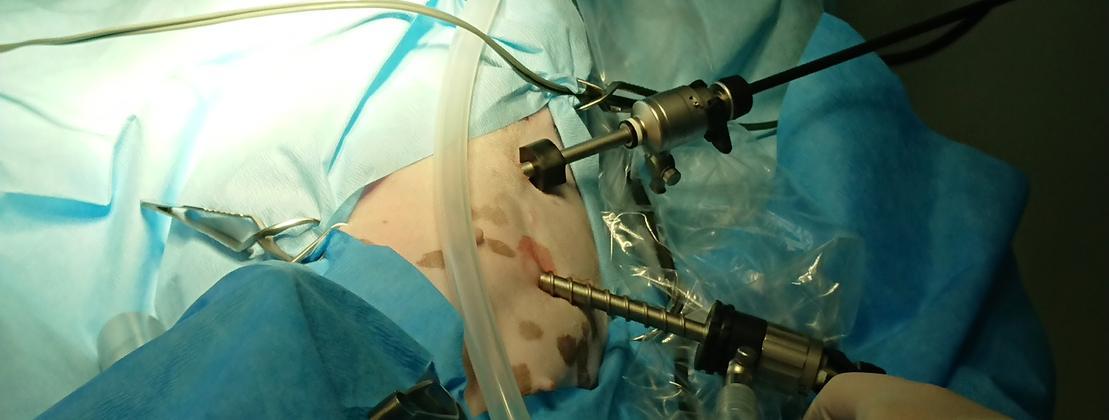Laparoscopic (Keyhole) Bitch Spays
Laparoscopy is defined as a surgical procedure during which a camera and instruments are inserted through the abdominal wall via small incisions (cuts). Due to the tiny size of the incisions involved laparoscopic procedures are commonly known as keyhole surgery. For a number of reasons laparoscopic techniques have been the preferred method for most routine abdominal surgical procedures in people for many years. We are extremely pleased to be able to offer the benefits of laparoscopy to our patients at Luxstowe Vets.
Main benefits of laparoscopic surgery
The extensive use of keyhole surgery in the human field provides substantial evidence of the benefits to utilising laparoscopic techniques. The same benefits are seen in animals:
Reduced pain post-operatively – smaller incisions dramatically reduce pain after operating.
Fewer stitches and smaller scars
Reduced risk of infection – the special instruments used ensure a protected environment for operating, minimising the chances of contamination.
Quicker return to exercise – with smaller incisions meaning less pain after operations, patients can often return to normal exercise much sooner than with conventional surgery.
Laparoscopic neutering (ovariectomy)
Historically neutering a bitch in the UK usually involved removing her ovaries and her uterus/womb (ovariohysterectomy – OVH). Over the last 40 years in much of mainland Europe the standard technique has been to remove just the ovaries (ovariectomy – OVE). Laparoscopic neutering of the bitch is carried out using the ovariectomy technique.
The surgery
Under a general anaesthetic the fur is clipped and skin disinfected in a similar way to a conventional operation. A laparoscopic spay is then performed through two or three small (5mm or 10mm in bigger dogs) incisions. A long narrow telescope is inserted to allow the surgeon to visualise the whole abdomen before concentrating on the all important ovaries. Further specialist instruments are used to remove the ovaries through one of the “keyholes” in the abdominal wall. Once both ovaries are safely removed a stitch is placed in the muscle layer with another buried stitch closing the skin.
After surgery the patient recovers from anaesthetic in a comfortable warm environment and is usually ready to go home within a few hours.
Once home we advise 2 days of rest (short trips to the toilet on a lead only) before 7 days exercising on a lead. After this, exercise levels can return to normal.
What about pyometra (womb infection) or uterus cancer?
One reason for using OVH to spay bitches was the concern regarding future womb infection or cancer. Research and widespread use of the OVE technique has allowed us a better understanding of the topic. The ovaries are the only natural source of the hormone progesterone in the bitch. Progesterone is known to be the hormone that causes the changes in the uterus necessary for a womb infection (pyometra) to develop. Therefore by completely removing the ovaries there is no greater risk of developing a future pyometra when compared with a conventional OVH technique.
Uterine cancer in dogs is very rare affecting only 3 in 10000 (0.03%) animals. The most common canine uterine tumour is called a leiomyoma – a slow growing benign type of tumour easily treated by hysterectomy. There is no current evidence of these tumours developing in animals neutered before the age of 2 meaning the risk of dogs developing uterine cancer is extremely low.
Other uses for laparoscopy
The same equipment can be used for a number of different procedures within the realm of modern veterinary science.
To examine the abdomen – the telescope allows a detailed visual internal examination of the whole abdomen within minutes.
To help diagnosis – samples (biopsies) can be taken from organs such as the liver, pancreas and kidneys to aid in the diagnosis of certain conditions.
To minimise trauma associated with other procedures – Laparoscopy can be used to assist in other operations such as gastropexy (stitching the stomach to the body wall) which is used as a preventative for twisted stomach in large breed dogs and can be performed at the same time as neutering. By using the laparoscope the surgical incisions can be kept to a minimum allowing for less pain and quicker patient recovery. Other “Lap-assisted” techniques include gut biopsy, retained testicle removal, uterus removal.
Kittens
Looking After your Puppy
Pregnancy, Labour & Problems
Post Op Care Notes
Special Offers
Veterinary Nurse Clinics
Pet Insurance
Laparoscopic (Keyhole) Bitch Spays
TTA Surgery
End Of Life
Repeat Prescriptions

